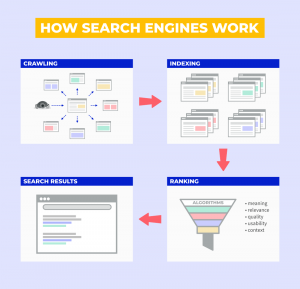Introduction:
This assignment will provide parenthetical, sentence, and expanded definitions of the term search engine optimization (SEO) to an audience of “non-technical readers”
Parenthetical Definition:
Search engine optimization (the process of improving your website to increase its visibility in search engines) is a fundamental part of digital marketing.
Sentence Definition:
Search engine optimization is a process that improves the quality and quantity of website traffic to a website, mainly through small modifications, which leads to the site ranking higher in search engines like Google, Bing, etc.
Expanded Definition:
What is Search Engine Optimisation (SEO)?
Search engine optimization is a process that improves the quality and quantity of unpaid traffic to a website (“SEO Starter Guide: The Basics | Google Search Central | Documentation | Google Developers”, 2022). Unpaid traffic is generated from image search, video search, academic search, etc. This is mainly through small modifications, such as modifications to page design, keyword-relevant content, updated content, etc, which leads to the site ranking higher on the results page of search engines like Google, Bing, etc.
Operating Principle:
Webmasters (people who are responsible for maintaining one or more websites )and content providers began optimizing websites for search engines in the mid-1990s, as the first search engines were cataloging the early Web. Initially, all webmasters only needed to submit the URL, or address of a page, to the various engines which would send a web crawler (an Internet bot that browses the Web systematically and that is typically operated by search engines for Web indexing) to crawl that page, extract links to other pages from it, and return information found on the page to be indexed (Pinkerton, 2000). This indexing process involves a search engine web crawler downloading a page and storing it on the search engine’s own server. A second program, known as an indexer, extracts information about the page, such as the words it contains, where they are located, and any weight for specific words, as well as all links the page contains. All of this information is then placed into a scheduler for crawling at a later date. This influences the ranking of web pages on search engine result pages (Pinkerton, 2000).

Figure 1. How Search Engines Work (Indexing & Crawling) Source: Polacek, Daniel. “Crawling & Indexing: How Google Checks Websites? | Mangools”. Mangools, 2020, https://mangools.com/blog/crawling-indexing/. Accessed 14 June 2022.
History of SEO:
Website owners recognized the value of a high ranking and visibility in search engine results, creating an opportunity for both white hat ( techniques that search engine companies recommend as part of good design) and black hat (techniques of which search engines do not approve) SEO practitioners. According to industry analyst Danny Sullivan, the phrase “search engine optimization” probably came into use in 1997. Bruce Clay is popularly credited as one of the first people to popularize the use of the term. To this day, SEO is an incredibly popular form of digital marketing. Since 2018, SEO jobs have nearly doubled and there has been a 7.6% increase in SEO job openings in 2019 vs 2020 (“Salary guide – USA”, 2022), indicating the continued demand from companies for this form of marketing.
Examples of Methods used for SEO:
A variety of methods can increase the prominence of a webpage within the search results. These methods include (“SEO Starter Guide: The Basics | Google Search Central | Documentation | Google Developers”, 2022):
- A good page design makes users trust a site and want to stay once they find it. When people click and leave a site, it counts against the site and affects its credibility.
- Websites that have content containing frequently searched keyword phrases, so as to be relevant to a wide variety of search queries, will tend to increase traffic.
- Updating content so as to keep search engines crawling back frequently can give additional weight to a site.
- Adding relevant keywords to a web page’s metadata, that is data that provides information about other data, will tend to improve the relevancy of a site’s search listings, thus increasing traffic.
Works Cited:
SEO Starter Guide: The Basics | Google Search Central | Documentation | Google Developers. (2022). Retrieved 10 June 2022, from https://developers.google.com/search/docs/beginner/seo-starter-guide
Introduction to CMS, SEO, SEM, and Attribution Modeling | Subhankar Da. (2022). Retrieved 10 June 2022, from https://www.taylorfrancis.com/chapters/mono/10.1201/9780429298509-1/introduction-cms-seo-sem-attribution-modeling-subhankar-das?context=ubx&refId=8436498c-8ea2-437d-ad8a-f141b0e9daff
Pinkerton, B. (2000). WebCrawler: Finding What People Wan (Ph.D). University of Washington.
Salary guide – USA. (2022). Retrieved 14 June 2022, from https://experience.conductor.com/digital-marketing-salary-guide-2021/p/2
Leave a Reply